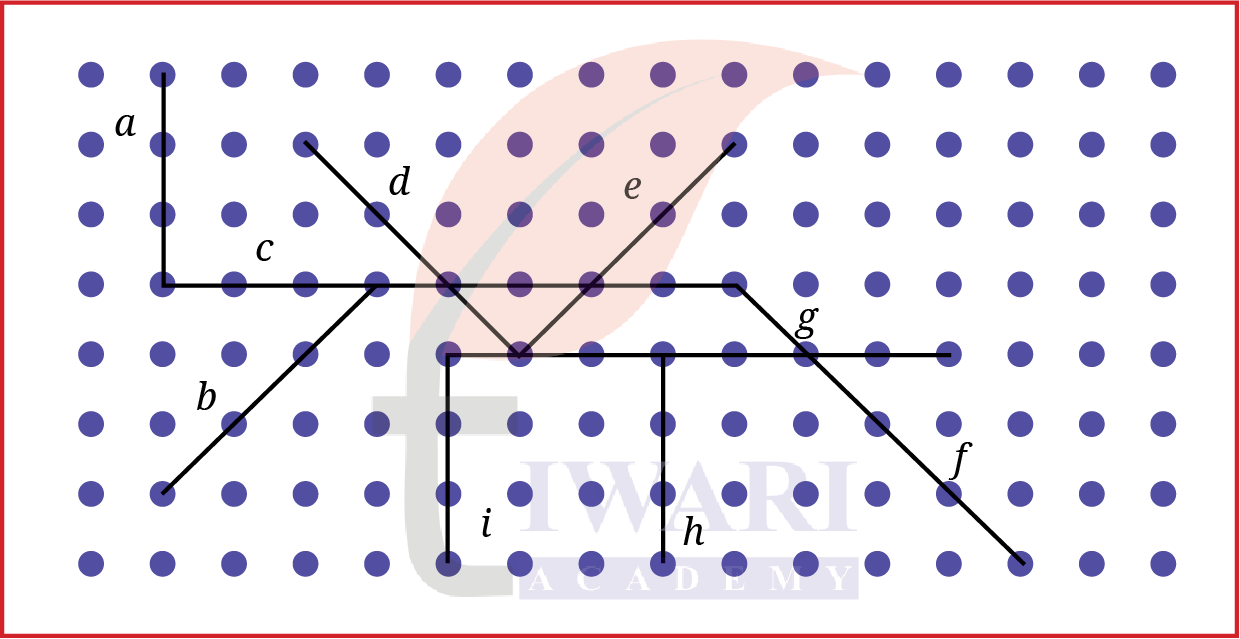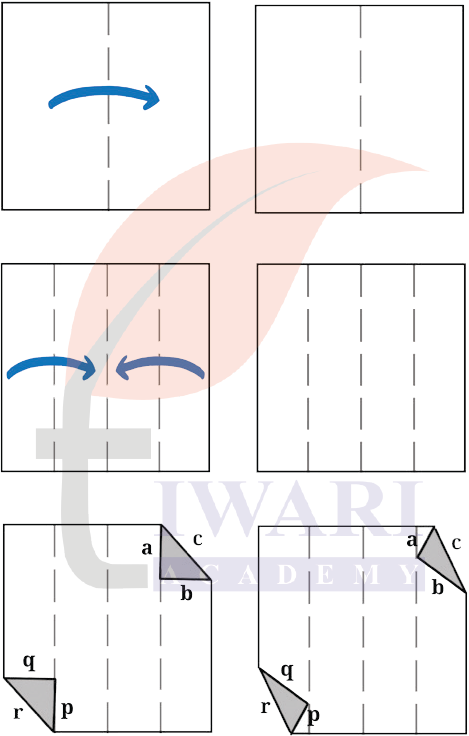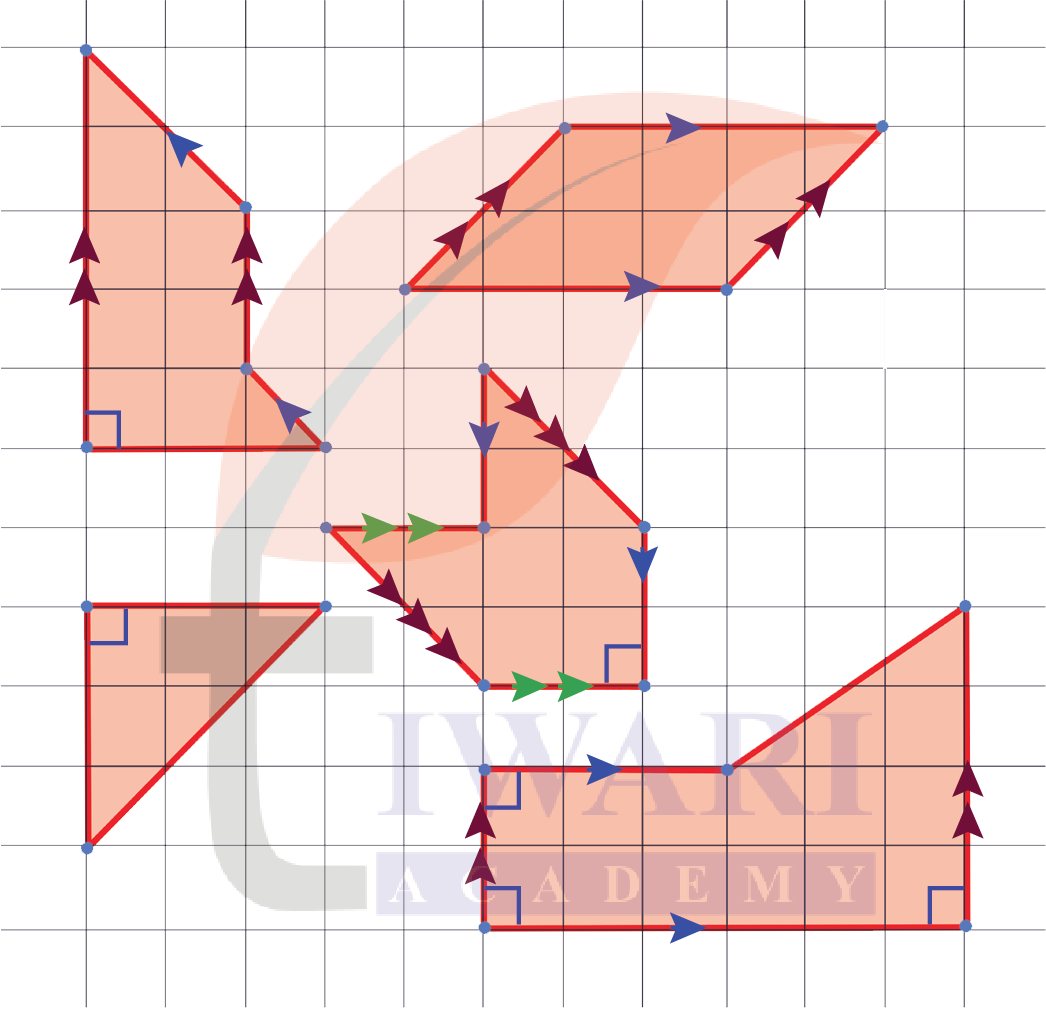NCERT Solutions for Class 7 Maths Ganita Prakash Chapter 5 Parallel and Intersecting Lines for Session 2025–26. Grade 7th Maths chapter 5 introduces students to the geometric relationships between lines, parallel, intersecting and perpendicular, on a plane. Through engaging activities like paper folding and drawing, students explore concepts such as linear pairs, vertically opposite angles, corresponding angles and alternate angles. It emphasizes how to identify and construct parallel and perpendicular lines using set squares and reasoning. Class 7 Ganit Prakash Lesson 5 also covers the role of transversals in forming angle pairs, making geometry more intuitive and practical.
Class 7 Maths all Chapters
Class 7 Maths Ganita Prakash Chapter 5 Solutions
Page 106
Section 5.1 Across the Line
How many angles do they form?
See SolutionFour angles are formed.

Page 107
Can two straight lines intersect at more than one point?
See SolutionNo, two distinct straight lines can intersect at most one point.
What patterns do you observe among these angles?
See SolutionThe patterns we observed among these angles are:
Vertically opposite angles are equal:
For example, in the figure, ∠a = ∠c and ∠b = ∠d.
Linear pairs add up to 180°:
Adjacent angles like ∠a + ∠b or ∠b + ∠c form a straight angle, which means their sum is always 180°.
These patterns are true for any pair of intersecting lines and form the basis of angle relationships in geometry.
In Fig. 5.2, if ∠a is 120°, can you figure out the measurements of ∠b, ∠c and ∠d, without drawing and measuring them?

See SolutionYes.
∠a + ∠b = 180 (linear pair)
=> ∠b = 180 – 120 = 60
∠c = ∠a = 120 (vertically opposite).
∠d = ∠b = 60 (vertically opposite).
So: ∠b = 60, ∠c = 120, ∠d = 60.
Is this always true for any pair of intersecting lines?
See SolutionYes, vertically opposite angles formed by any pair of intersecting lines are always equal.
Page 108
Figure it Out
List all the linear pairs and vertically opposite angles you observe in Fig. 5.3:

See Solution Linear Pairs (adjacent angles on a straight line, sum = 180 degrees):
∠a and ∠b
∠b and ∠c
∠c and ∠d
∠d and ∠a
Pairs of Vertically Opposite Angles (angles opposite at the intersection, are equal):
∠a and ∠c
∠b and ∠d
5.2 Perpendicular Lines
Can you draw a pair of intersecting lines such that all four angles are equal? Can you figure out what will be the measure of each angle?

See Solution Yes, this is possible if all four angles are equal, each angle must be a right angle (90 degrees). We say such lines as perpendicular lines.
Page 110
Which pairs of lines appear to be parallel in Fig. 5.6 below?

See Solution(Based on visual inspection of Figure 5.6 on the page)
Line segment ‘a’ appears parallel to line segment ‘i’ and ‘h’.
Line segment ‘c’ appears parallel to line segment ‘g’.
Line segment ‘b’ appears parallel to line segment ‘e’.
Line segment ‘d’ appears parallel to line segment ‘f’.
Page 111
5.4 Parallel and Perpendicular Lines in Paper Folding
Activity 2
Take a plan square of paper (use a newspaper for this activity).
How would you describe the opposite edges of the sheet? They are ______ to each other.
See AnswerParallel
How would you describe the adjacent edges of the sheet? The adjacent edges are ______ to each other. They meet at a point. They form right angles.
See AnswerPerpendicular
Fold the sheet horizontally in half. A new line is formed (see Fig. 5.7).
See AnswerThe two original top/bottom edges and the new horizontal fold.
How many parallel lines do you see now? How does the new line segment relate to the vertical sides?

See Solution It is perpendicular to the vertical sides.
Make on one more horizontal fold in the folded sheet. How many parallel lines do you see now?
See Solution 5 parallel lines (the two original edges plus the three horizontal folds).
What will happen if you do it once more? How many parallel lines will you get? Is there a pattern? Check if the pattern extends further, if you make another horizontal fold.
See Solution Doing it once more (a third horizontal fold) would result in 9 parallel lines (2 original edges + 7 folds).
The pattern relates to powers of 2; after n folds, we have 2ⁿ⁻¹ fold lines, plus the 2 original edges for 2ⁿ⁺¹ total parallel lines (starting from n=1 fold).
We can check if the pattern continues.
Make a vertical fold in the square sheet. This new vertical line is ______ to the previous horizontal lines.
See SolutionPerpendicular
Fold the sheet along a diagonal. Can you find a fold that creates a line parallel to the diagonal line?
See Solution This requires performing the activity. It is possible to create such a fold (e.g., by folding an edge onto the diagonal or folding the paper in half parallel to the first diagonal fold).
Page 112

Here is another activity for you to try.
•Take a square sheet of paper, fold it in the middle and unfold it.
•Fold the edges towards the centre line and unfold them.
•Fold the top right and bottom left corners onto the creased line to create triangles. Refer to Fig. 5.8.
•The triangles should not cross the crease lines.
•Are a, b and c parallel to p, q and r respectively? Why or why not?
See SolutionFrom Figure 5.8, we can see the final result shows:
Line segments a, b and c (the fold lines/creases)
Line segments p, q and r (the edges of the triangular folds)
No, they are not parallel.
Reason:
Lines a, b and c are vertical crease lines running from top to bottom of the paper
Lines p, q and r are the diagonal edges of the triangular folds created when we fold the corners
Since the crease lines run vertically and the triangle edges run diagonally, they intersect each other rather than being parallel. Parallel lines never intersect and always maintain the same distance apart, but here we can see that the vertical crease lines and diagonal triangle edges cross each other at various points.
The triangular folds create diagonal lines that cut across the vertical crease lines at angles, which is why the instruction specifies that “the triangles should not cross the crease lines” – to maintain the proper geometric relationship for this folding exercise.
Page 113
Figure it Out
1. Draw some lines perpendicular to the lines given on the dot paper in Fig. 5.10.

Answer:

2. In Fig. 5.11, mark the parallel lines using the notation above (single arrow, double arrow etc.). Mark the angle between perpendicular lines with a square symbol.

(a) How did you spot the perpendicular lines?
(b) How did you spot the parallel lines?
Answer:
Lines are shown in the following figures.

See Explanation(a) Perpendicular lines are typically spotted by identifying lines that meet at a 90-degree angle (a right angle). On dot or grid paper, this looks like the corner of a square or rectangle aligned with the grid lines or lines whose slopes are negative reciprocals of each other.
(b) Parallel lines are spotted by identifying lines that have the same direction or slope and always remain the same distance apart. On dot paper, they form opposite sides of shapes like parallelograms, rectangles or trapezoids or they connect dots with the same horizontal and vertical displacement.
Is Class 7 Maths Ganita Prakash Chapter 5 easy?
Yes, Class 7 Maths Ganita Prakash Chapter 5 is considered easy and interesting for most students once they understand the basic terms and visual concepts. Class 7 Maths Ganita Prakash Chapter 5 deals with fundamental geometry, focusing on how lines behave on a plane—whether they meet, remain apart or form specific angles. Using diagrams, paper folding and real-life examples, the concepts are made engaging. With consistent practice and understanding of terms like intersecting lines, parallel lines, and transversals, students usually find the chapter manageable. Even those who are weak in geometry can score well with visual learning and simple activities.
How can we score maximum in Class 7 Maths Ganita Prakash Chapter 5?
To score maximum in Chapter 5 of Class 7 Ganita Prakash, students should first become familiar with key definitions like intersecting lines, parallel lines, perpendicular lines and transversals. Drawing clear diagrams with proper notation (arrows for parallel lines and squares for right angles) is essential. Practicing activities like paper folding helps in concept clarity. Focus on understanding the properties of angles—linear pairs, vertically opposite angles, corresponding and alternate angles. Solve all in-text and exercise problems thoroughly and try additional questions from reference books. Reviewing solved examples and summary points can also aid in better retention and scoring full marks.
What are the main concepts given in Class 7 Ganita Prakash Chapter 5?
The main concepts in Chapter 5 Parallel and Intersecting Lines include understanding the behavior and relationships between different lines on a plane. It covers:
1. Intersecting lines and the angles they form (like vertically opposite and linear pairs).
2. Perpendicular lines and how they form four right angles.
3. Parallel lines that never meet even when extended.
4. Transversals that cut through two lines, forming eight angles.
5. Special angle pairs such as corresponding angles and alternate angles.
Class 7 Maths Ganita Prakash Chapter 5 emphasizes visual learning through paper folding and geometric drawing, ensuring that students grasp these foundational geometry ideas effectively and interactively.
What are the difficult areas of Class 7 Maths Chapter 5?
Some students may find difficulty in identifying angle relationships, especially between corresponding and alternate angles formed by a transversal. Drawing neat, accurate diagrams with proper angle measures and line notations (like using arrows for parallel lines or squares for right angles) can also be tricky. Understanding why certain angle pairs are equal or supplementary requires logical thinking rather than memorization. Another challenging area is using protractors and set squares correctly to verify or construct parallel and perpendicular lines. To overcome these hurdles, regular practice with both hands-on activities and exercises is important, along with guidance from teachers when needed.


